Tittar du på kartan ser du hur ytterligt litet EU är jämfört med de länder flyktingarna kommer ifrån. Hur många som kommer framöver ser du på den troliga utvecklingen
 |
| https://ourworldindata.org/world-population-growth/ |
Se Europe Is Facing Influx of Hundreds of Millions of Refugees, Israeli Professor Warns
Inget i EUs dyra immigrationsplaner nämner den förväntade explosiva befolkningsutvecklingen. Vad gör de ovalda EU-kejsarna när det kommer 10 miljoner eftersom de inte totalstoppat inmarschen?
Flyktingar kommer dit ryktet har sagt att de får allt betalt. EU försöker inte stoppa ryktet.
Jämför med Israel. Minns hur lilla Israel fick in 60.000 illegala infiltratörer och gjorde något åt det. Länk. 2012 kom 2.000 per månad, nästa år var det 54. Man kan alltså om man har lust.
Migrant crisis: Migration to Europe explained in seven charts
- 4 March 2016
- Europe
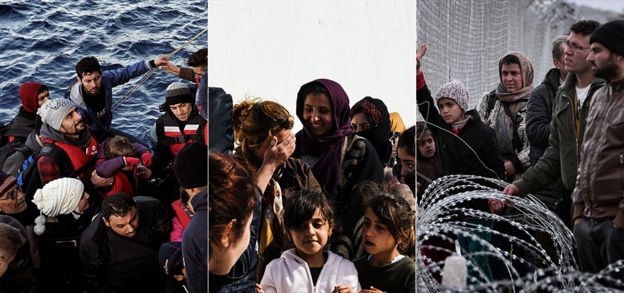
More than a million migrants and refugees crossed into Europe in 2015, sparking a crisis as countries struggled to cope with the influx, and creating division in the EU over how best to deal with resettling people.
The vast majority arrived by sea but some migrants have made their way over land, principally via Turkey and Albania.
Winter has not stemmed the flow of people - with 135,711 people reaching Europe by sea since the start of 2016, according to the UNHCR.
1. Which countries are migrants from?
The conflict in Syria continues to be by far the biggest driver of migration. But the ongoing violence in Afghanistan and Iraq, abuses in Eritrea, as well as poverty in Kosovo, are also leading people to look for new lives elsewhere.

2. Where are migrants going?
Although not all of those arriving in Europe choose to claim asylum, many do. Germany received the highest number of new asylum applications in 2015, with more than 476,000.
But far more people have arrived in the country - German officials said more than a million had been counted in Germany's "EASY" system for counting and distributing people before they make asylum claims.
Hungary moved into second place for asylum applications, as more migrants made the journey overland through Greece and the Western Balkans. It had 177,130 applications by the end of December.
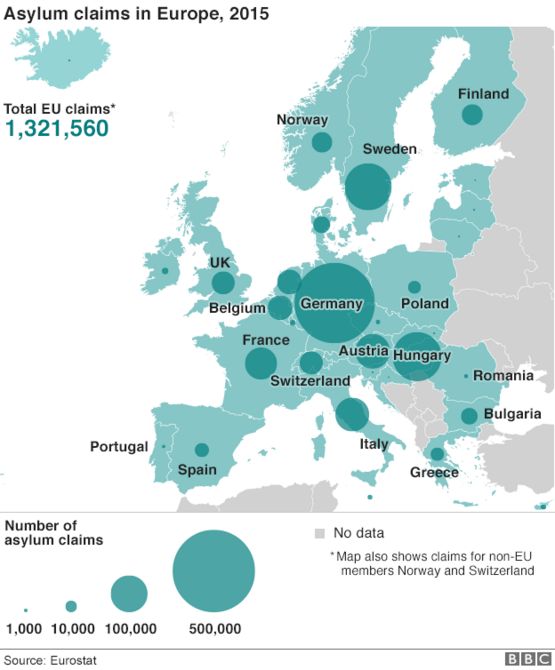
3. How do migrants get to Europe?
The International Organization for Migration (IOM) estimates that more than 1,011,700 migrants arrived by sea in 2015, and almost 34,900 by land.
This compares with 280,000 arrivals by land and sea for the whole of 2014. The figures do not include those who got in undetected.
The EU's external border force, Frontex, monitors the different routes migrants use and numbers arriving at Europe's borders and put the figure crossing into Europe in 2015 at more than 1,800,000.
Most of those heading for Greece take the relatively short voyage from Turkey to the islands of Kos, Chios, Lesvos and Samos - often in flimsy rubber dinghies or small wooden boats.
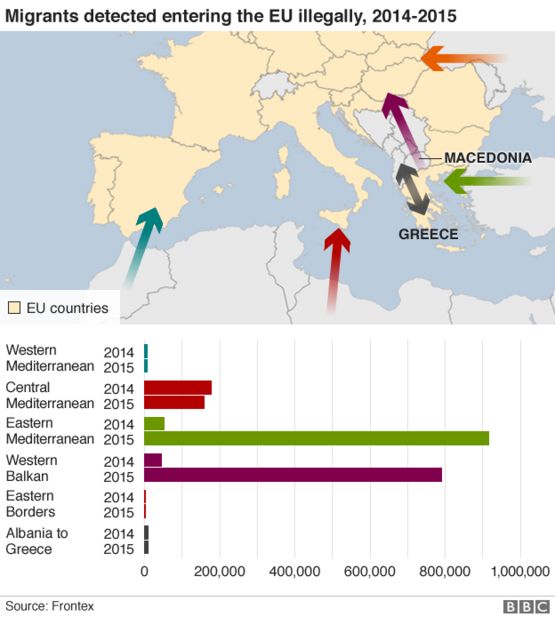
4. How dangerous is the journey?
According to the IOM, more than 3,770 migrants were reported to have died trying to cross the Mediterranean in 2015.
Most died on the crossing from north Africa to Italy, and more than 800 died in the Aegean crossing from Turkey to Greece.
The summer months are usually when most fatalities occur as it is the busiest time for migrants attempting to reach Europe.
But in 2015, the deadliest month for migrants was April, which saw a boat carrying about 800 people capsize in the sea off Libya. Overcrowding is thought to have been one of the reasons for the disaster.
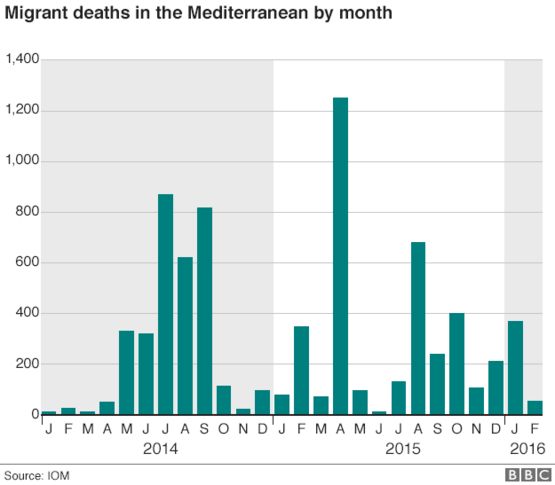
5. Which European countries are most affected?
Although Germany has had the most asylum applications in 2015, Hungary had the highest in proportion to its population, despite having closed its border with Croatia in an attempt to stop the flow in October. Nearly 1,800 refugees per 100,000 of Hungary's local population claimed asylum in 2015.
Sweden followed close behind with 1,667 per 100,000.
The figure for Germany was 587 and for the UK it was 60 applications for every 100,000 residents. The EU average was 260.
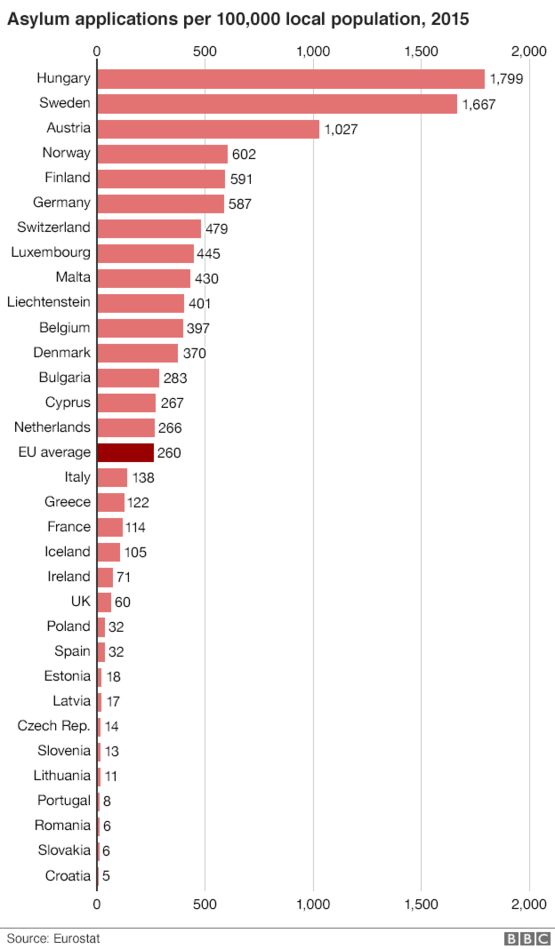
6. How has Europe responded?
Tensions in the EU have been rising because of the disproportionate burden faced by some countries, particularly the countries where the majority of migrants have been arriving: Greece, Italy and Hungary.
In September, EU ministers voted by a majority to relocate 160,000 refugees EU-wide, but for now the plan will only apply to those who are in Italy and Greece.
Another 54,000 were to be moved from Hungary, but the Hungarian government rejected this plan and will instead receive more migrants from Italy and Greece as part of the relocation scheme.
The UK has opted out of any plans for a quota system but, according to Home Office figures, 1,000 Syrian refugees were resettled under the Vulnerable Persons Relocation scheme in 2015. Prime Minister David Cameron has said the UK will accept up to 20,000 refugees from Syria over the next five years.

7. How many asylum claims are approved?
Although huge numbers have been applying for asylum, the number of people being given asylum is far lower.
In 2015, EU countries offered asylum to 292,540 refugees. In the same year, more than a million migrants applied for asylum - although applying for asylum can be a lengthy procedure so many of those given refugee status may have applied in previous years.
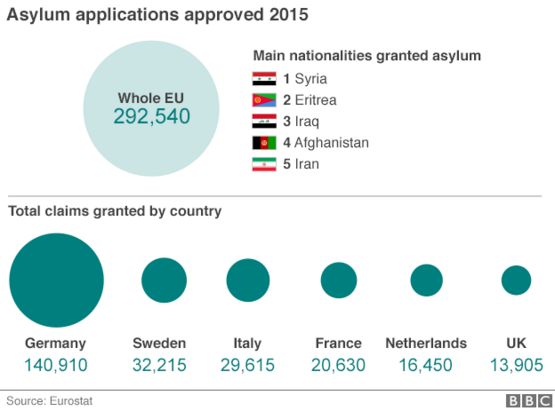
A note on terminology: The BBC uses the term migrant to refer to all people on the move who have yet to complete the legal process of claiming asylum. This group includes people fleeing war-torn countries such as Syria, who are likely to be granted refugee status, as well as people who are seeking jobs and better lives, who governments are likely to rule are economic migrants.
Inga kommentarer :
Skicka en kommentar
Tack för kommentar - jag godkänner när jag har läst den! Om den är värd att godkännas :)